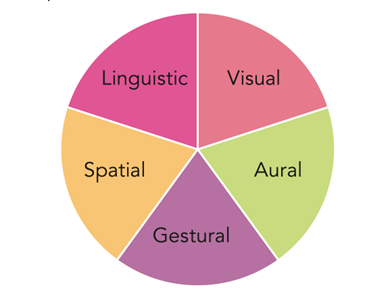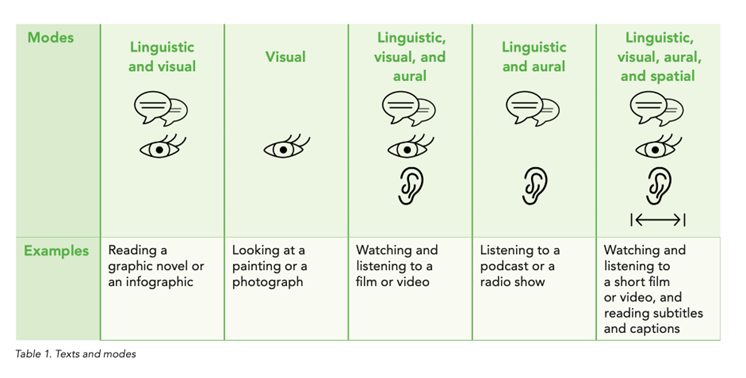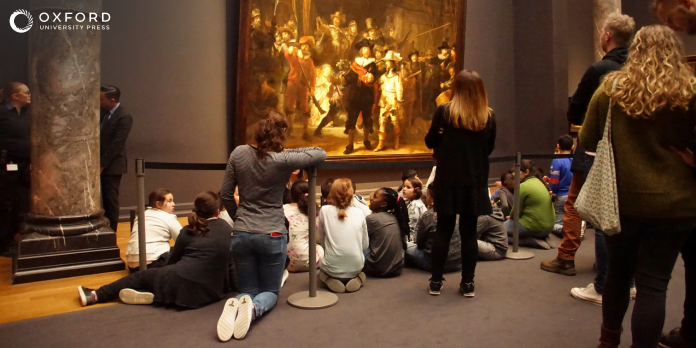From my extensive experience of training English language teachers from all around the world, I believe that many teachers have heard of the concept of multimodality but the majority are unsure of its exact meaning and its relevance to English language teaching. In this article, I will try to clarify what multimodality is and how it is highly relevant to English language teachers and learners. We will begin by exploring the changing nature of literacy and communication in the digital age. We will then clarify what a mode of communication is and examine the different modes. Finally, we’ll go on to explore the concepts of multimodality and multimodal literacy and their relevance to English language teaching and learning.
Why and how is the nature of literacy and communication changing?
Traditionally, literacy has been understood as learning to read and write alphabetic text. However, in contemporary society, communication is increasingly digital and multimodal. The majority of texts our students access, for example, YouTube videos, social media posts, and website articles, are no longer word on page but include various modes of communication such as videos, images, and audio. It is essential to acknowledge that present-day communication is much more than writing and speech, and that literacy is much more than language. For our students to master today’s textual world, they need much more than the ability to read and write words and sentences. Writing and speech are only two of the many modes used in contemporary communication.

What is a mode?
A mode is a means of communicating. Each mode serves different purposes and works in different ways. It is essential for our students to be aware of the different modes used in communication to fully understand the meanings that are being conveyed.
There are five modes of communication: linguistic; aural; visual, gestural; and spatial, as illustrated in Figure 1.
Linguistic mode
The linguistic mode focuses on the meaning of written or spoken language in communication. This includes choice of words, the organisation of words into sentences and paragraphs, vocabulary, and grammar.
Visual mode
The visual mode focuses on the meaning of what can be seen by the viewer. This includes images, signs, symbols, and videos. It also includes aspects of visual design such as colour, layout, font type and size.
Aural mode
The aural mode focuses on the meaning of what can be heard by the listener. This includes voice, ambient noise, music, and silence.
Gestural mode
The gestural mode focuses on the meaning of communication through movement. This includes facial expressions, body language, hand gestures, and interaction between people.
Spatial mode
The spatial mode focuses on the meaning of communication through physical layout. This includes position, spacing, the distance between elements in a text, and proximity between people/objects.
What is a multimodal text?
When a text contains more than one of these modes it is multimodal. Multimodal texts can be both paper-based or digital in nature. Paper-based multimodal texts include picture books, graphic novels, and comics. Digital multimodal texts, such as videos, vlogs, and websites. Table 1 shows the mode/s present in a number of different texts.

Table 1. Texts and Modes
What is multimodality?
Multimodality refers to the use of more than one mode of communication in a text to create meaning. The concept of multimodality describes how each mode contributes to the overall meaning of a multimodal text. In present-day communication, most texts our students encounter are multimodal texts that combine alphabetic text, images, and other modes. As contemporary communication is increasingly digital and multimodal, how meaning is made across different modes has become increasingly important.
What is multimodal literacy?
Multimodal literacy refers to the ability to comprehend and respond to multimodal texts and to create multimodal texts. Responding to the ever-changing contemporary communication environment, many education systems around the world have reformed their literacy curricula to include multimodal literacy. For example, in Singapore, the 2020 language syllabus integrates the skills of viewing and representing with listening, reading, speaking, and writing to include meaning-making across different modes of communication in multimodal texts. The term multimodal literacy brings viewing and representing together in a single concept.
What is viewing?
Viewing refers to the active process of understanding and responding to multimodal texts. At the basic level, viewing involves students noticing the different modes of communication used in the multimodal text and responding to them on an emotional level. At the higher level, viewing involves students analysing and interpreting the multimodal text and responding to it critically. Viewing is linked with the receptive skills of reading and listening.
What is representing?
Representing refers to students communicating information and ideas through the creation of multimodal texts. Typical examples of paper-based multimodal texts we can ask our students to create include posters, comic strips, and, storyboards. Typical examples of digital multimodal texts we can encourage our students to create include videos, slide presentations, and memes. The productive skills of writing and speaking are linked with representing.
Why is multimodal literacy important in ELT?
As contemporary communication is increasingly multimodal, we need to rethink the concept of communicative competence in ELT. Although our main focus as English language teachers should be on language, we also need to be able to help students develop their multimodal communicative competence. We need to help students appreciate and understand how images and other modes in multimodal texts interact with spoken and written language. The vast majority of texts – YouTube videos, websites, blogs, social media sites – our students are accessing outside the classroom are multimodal texts and we should give our students opportunities to critically view these types of texts in the classroom. We can help students explore how these different modes used in these texts interact to create a communicative act. The development of multimodal literacy prepares our students to be effective communicators. Would you agree with this? What type of multimodal texts do you use in your classrooms? How do you use multimodal texts with your students?
If you want to learn more about multimodal literacy and how to implement it in your classroom, you can download our position papers.
References:
Ministry of Education (MOE), Singapore (2020). English language teaching and learning syllabus 2020. Ministry of Education.
Kieran Donaghy is the Director of Pedagogy of The School for Training, a specialist teacher development institute in Barcelona, and Film English, an independent digital publishing company. He is a writer, conference speaker, and trainer who works with teachers all over the world. He is the author of books for students and teachers of English as a foreign language. He is the founder of The Image Conference, the only conference exclusively on the use of images in language teaching, and co-founder of the Visual Arts Circle, a professional community of practice for language education professionals interested in the use of the visual arts in language teaching. In 2013, he was awarded the British Council ELTONs award for Innovation in Teacher Resources. Kieran is the author of our paper on Multimodality in ELT.




A very interesting article, with a clear direction to what we need to focus on! I have read the Position Paper too, and I find multimodal communicative competence a very challenging objective. Students are also very pleased about how they need to cultivate their communication skills in this direction.
Thanks for the elucidation on these terms and for the connection between multimodal literacy and English language learning. By adopting this approach to authentic texts, I have been getting students to realize that they are “reading” the world they live in, since most of them (teenagers) limit reading and literacy to alphabetic text, and consequently, a boring task.